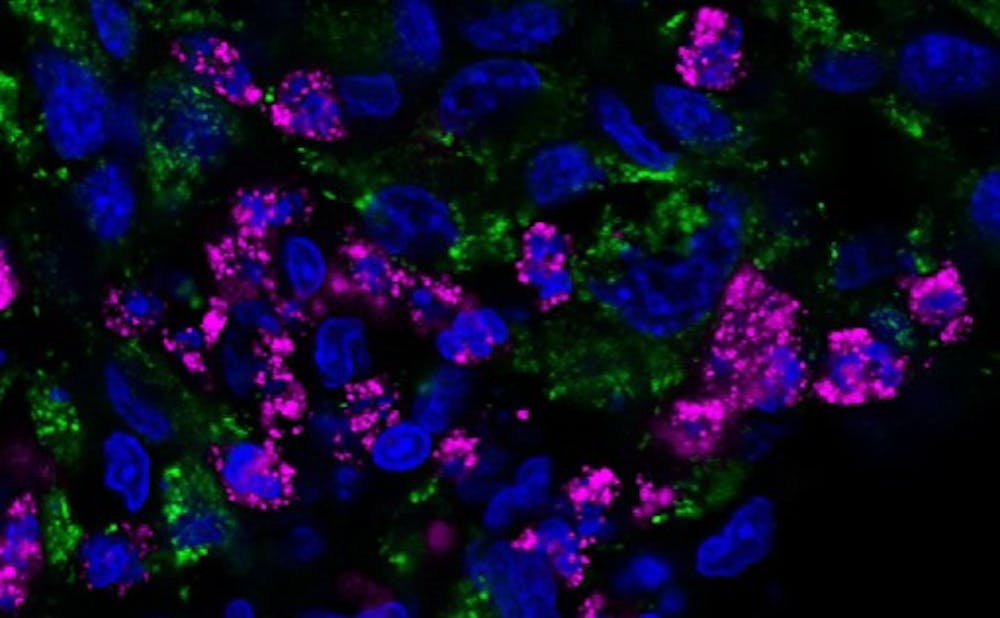Although most people associate salmonella with a bad case of food poisoning, a team of Duke scientists have shown that the bacteria could potentially be used to treat cancer.
Led by Ravi Bellamkonda, Vinik Dean of the Pratt School of Engineering, the researchers adopted a strain of Salmonella typhimurium and made several genetic modifications to the bacterial DNA. These changes enabled the bacteria to produce tumor suppressor proteins called p53 and Azurin, which were able to destroy glioblastoma tumors in the brains of nearly 20 percent of the mice tested.
“One of the challenges of glioblastoma is its tendency to infiltrate the rest of the brain, blurring the boundaries of where tumor is and where normal brain is,” Bellamkonda said.
The metastasis, or invasive spread, of the cancer prevents doctors from surgically removing the tumor and requires a more creative solution to the problem. To accomplish this, the team turned to a strain of salmonella developed in the laboratory of David Bermudes, associate professor of biology at California State University at Northridge.
“They removed this toxic protein that’s expressed on the bacterial cells,” said Johnathan Lyon, a study co-author and Ph.D. candidate in Bellamkonda’s lab. “[The modified bacteria] are essentially just like the healthy bacteria in your body. They don’t really warrant an immune response.”
Lyon noted that the bacteria are altered so that they are unable to produce a key nutrient called purine. Tumors are purine-rich, however, causing the bacteria to seek out the tumors for survival.
The Duke researchers also made several additional tweaks of their own to the bacteria’s genome.
“We’ve made it so that once it reaches the tumor, it triggers a manufacturing of drug combination p53 and Azurin,” Lyon said.
The protein p53 initiates the process of cell death when released inside a cell. Lyon explained that the bacteria are able to penetrate the cell membrane and deliver their payload of p53, leading to the destruction of the tumor cell.
Bellamkonda added that the researchers also built in a safeguard to ensure that the bacteria would not release p53 when taken in by a healthy cell.
“Only in regions where the oxygen is low would these proteins be turned on,” Bellamkonda said. “For the most part, the oxygen concentration tends to be pretty high, except in the regions of cancer where the tumors are growing so fast.”
This newly-modified strain was then tested in mice that had received grafts of human glioblastoma cells.
“We found that 20 percent of those animals survived indefinitely, which was pretty surprising,” Lyon said.
Although the other 80 percent of the mice eventually succumbed to the cancer, there were still hopeful signs, the researchers explained.
“We showed that even in 80 percent in the cases that survival was not positively affected, we do have evidence of an initial fight from the bacterial expression, which is then overcome by the aggressive tumors,” Bellamkonda said.
Bellamkonda, however, is looking for a higher efficacy rate in the treatment as it moves on to other animal and human trials. He said he expected this would take anywhere from five to 10 years.
“This is just our first initial study, and we just prototyped a basic drug delivery system that would only work in these tumors," Lyon said. "There are a lot of modifications to do to push that forward."
Lyon mentioned an increased precision of response and a stronger cocktail of proteins as two possibilities for improvement.
“I welcome approaches like this that are a little out of the box from engineers and others, who are not just looking for a magic chemical drug to cure all cancer, but thinking of creative ways in which to approach treating metastatic cancer,” Bellamkonda said. “If this therapy leads others to think of other creative ways, we welcome that.”
Get The Chronicle straight to your inbox
Signup for our weekly newsletter. Cancel at any time.

